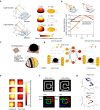Differential perovskite hemispherical photodetector for intelligent imaging and location tracking
- PMID: 38233400
- PMCID: PMC10794423
- DOI: 10.1038/s41467-024-44857-4
Differential perovskite hemispherical photodetector for intelligent imaging and location tracking
Abstract
Advanced photodetectors with intelligent functions are expected to take an important role in future technology. However, completing complex detection tasks within a limited number of pixels is still challenging. Here, we report a differential perovskite hemispherical photodetector serving as a smart locator for intelligent imaging and location tracking. The high external quantum efficiency (~1000%) and low noise (10-13 A Hz-0.5) of perovskite hemispherical photodetector enable stable and large variations in signal response. Analysing the differential light response of only 8 pixels with the computer algorithm can realize the capability of colorful imaging and a computational spectral resolution of 4.7 nm in a low-cost and lensless device geometry. Through machine learning to mimic the differential current signal under different applied biases, one more dimensional detection information can be recorded, for dynamically tracking the running trajectory of an object in a three-dimensional space or two-dimensional plane with a color classification function.
© 2024. The Author(s).
Conflict of interest statement
The authors declare no competing interests.
Figures




Similar articles
-
Stable and Lead-Free Perovskite Hemispherical Photodetector for Vivid Fourier Imaging.Adv Sci (Weinh). 2025 Feb;12(7):e2414430. doi: 10.1002/advs.202414430. Epub 2024 Dec 24. Adv Sci (Weinh). 2025. PMID: 39717012 Free PMC article.
-
Lead-Free Perovskite Hemispherical Photodetector for Single-Pixel Imaging Encryption and Trajectory Tracking.Nano Lett. 2025 Aug 19. doi: 10.1021/acs.nanolett.5c03198. Online ahead of print. Nano Lett. 2025. PMID: 40830079
-
Spray-coated perovskite hemispherical photodetector featuring narrow-band and wide-angle imaging.Nat Commun. 2022 Oct 15;13(1):6106. doi: 10.1038/s41467-022-33934-1. Nat Commun. 2022. PMID: 36243753 Free PMC article.
-
Recent Advances in Perovskite Photodetectors for Image Sensing.Small. 2021 May;17(18):e2005606. doi: 10.1002/smll.202005606. Epub 2021 Mar 16. Small. 2021. PMID: 33728799 Review.
-
Recent progress in construction methods and applications of perovskite photodetector arrays.Nanoscale Horiz. 2023 Jul 24;8(8):1014-1033. doi: 10.1039/d3nh00119a. Nanoscale Horiz. 2023. PMID: 37337833 Review.
Cited by
-
Chiral Perovskite Single Crystals: Toward Promising Design and Application.Materials (Basel). 2025 Jun 4;18(11):2635. doi: 10.3390/ma18112635. Materials (Basel). 2025. PMID: 40508631 Free PMC article. Review.
-
Intelligent Photodetectors: Postmanufacturing Tunability toward Enhanced Performance and Advanced Functions.Chem Rev. 2025 Aug 13;125(15):6977-7022. doi: 10.1021/acs.chemrev.4c00763. Epub 2025 Jul 21. Chem Rev. 2025. PMID: 40686380 Free PMC article. Review.
-
Seeing through arthropod eyes: An AI-assisted, biomimetic approach for high-resolution, multi-task imaging.Sci Adv. 2025 May 23;11(21):eadt3505. doi: 10.1126/sciadv.adt3505. Epub 2025 May 21. Sci Adv. 2025. PMID: 40397741 Free PMC article.
-
Stable and Lead-Free Perovskite Hemispherical Photodetector for Vivid Fourier Imaging.Adv Sci (Weinh). 2025 Feb;12(7):e2414430. doi: 10.1002/advs.202414430. Epub 2024 Dec 24. Adv Sci (Weinh). 2025. PMID: 39717012 Free PMC article.
-
Direct integration of optoelectronic arrays with arbitrary non-developable structures.Nat Mater. 2025 Aug 14. doi: 10.1038/s41563-025-02322-7. Online ahead of print. Nat Mater. 2025. PMID: 40813914
References
-
- Wang T, et al. Image sensing with multilayer nonlinear optical neural networks. Nat. Photonics. 2023;17:408–415. doi: 10.1038/s41566-023-01170-8. - DOI
-
- Gao W, Xu Z, Han X, Pan C. Recent advances in curved image sensor arrays for bioinspired vision system. Nano Today. 2022;42:101366. doi: 10.1016/j.nantod.2021.101366. - DOI
LinkOut - more resources
Full Text Sources

